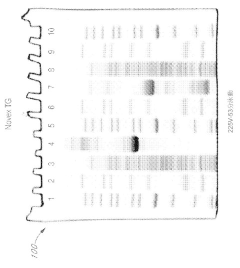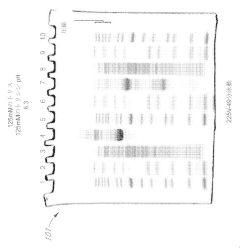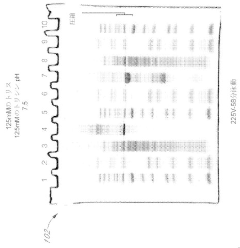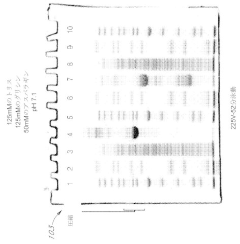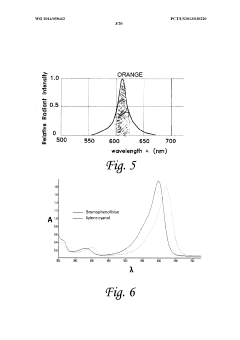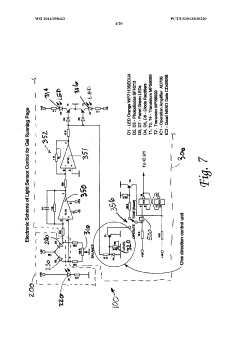Gel Electrophoresis in Functional Lipidomics: Key Advances
JUL 1, 20259 MIN READ
Generate Your Research Report Instantly with AI Agent
Patsnap Eureka helps you evaluate technical feasibility & market potential.
Lipidomics Background
Lipidomics, a rapidly evolving field within the broader domain of metabolomics, focuses on the comprehensive analysis of lipids in biological systems. This discipline has gained significant importance in recent years due to the crucial roles lipids play in cellular functions, signaling pathways, and disease processes. The emergence of lipidomics can be traced back to the early 2000s, coinciding with advancements in mass spectrometry and chromatography techniques.
The fundamental goal of lipidomics is to provide a holistic view of lipid metabolism, distribution, and interactions within cells, tissues, and organisms. This approach enables researchers to unravel the complexities of lipid-related biological processes and their implications in health and disease. Lipidomics encompasses the study of a vast array of lipid species, including fatty acids, glycerolipids, glycerophospholipids, sphingolipids, and sterol lipids, among others.
The development of lipidomics has been driven by technological advancements in analytical chemistry and bioinformatics. Mass spectrometry, particularly electrospray ionization (ESI) and matrix-assisted laser desorption/ionization (MALDI), has been instrumental in enabling high-throughput and high-sensitivity lipid analysis. These techniques, coupled with liquid chromatography and gas chromatography, have revolutionized the ability to identify and quantify thousands of lipid species in complex biological samples.
Functional lipidomics, a subset of the broader lipidomics field, focuses on elucidating the biological roles and mechanisms of lipids in cellular processes. This approach combines traditional lipidomics techniques with functional assays and molecular biology methods to provide a more comprehensive understanding of lipid dynamics and their impact on cellular physiology.
Gel electrophoresis, a classical technique in molecular biology, has found renewed applications in functional lipidomics. While traditionally used for separating proteins and nucleic acids, adapted forms of gel electrophoresis have proven valuable for lipid analysis. These adaptations allow for the separation and characterization of lipid species based on their physicochemical properties, providing complementary information to mass spectrometry-based approaches.
The integration of gel electrophoresis techniques in functional lipidomics has opened new avenues for investigating lipid-protein interactions, lipid trafficking, and membrane dynamics. This synergy between established molecular biology methods and cutting-edge lipidomics approaches has contributed to a more nuanced understanding of lipid biology and its implications in various physiological and pathological conditions.
The fundamental goal of lipidomics is to provide a holistic view of lipid metabolism, distribution, and interactions within cells, tissues, and organisms. This approach enables researchers to unravel the complexities of lipid-related biological processes and their implications in health and disease. Lipidomics encompasses the study of a vast array of lipid species, including fatty acids, glycerolipids, glycerophospholipids, sphingolipids, and sterol lipids, among others.
The development of lipidomics has been driven by technological advancements in analytical chemistry and bioinformatics. Mass spectrometry, particularly electrospray ionization (ESI) and matrix-assisted laser desorption/ionization (MALDI), has been instrumental in enabling high-throughput and high-sensitivity lipid analysis. These techniques, coupled with liquid chromatography and gas chromatography, have revolutionized the ability to identify and quantify thousands of lipid species in complex biological samples.
Functional lipidomics, a subset of the broader lipidomics field, focuses on elucidating the biological roles and mechanisms of lipids in cellular processes. This approach combines traditional lipidomics techniques with functional assays and molecular biology methods to provide a more comprehensive understanding of lipid dynamics and their impact on cellular physiology.
Gel electrophoresis, a classical technique in molecular biology, has found renewed applications in functional lipidomics. While traditionally used for separating proteins and nucleic acids, adapted forms of gel electrophoresis have proven valuable for lipid analysis. These adaptations allow for the separation and characterization of lipid species based on their physicochemical properties, providing complementary information to mass spectrometry-based approaches.
The integration of gel electrophoresis techniques in functional lipidomics has opened new avenues for investigating lipid-protein interactions, lipid trafficking, and membrane dynamics. This synergy between established molecular biology methods and cutting-edge lipidomics approaches has contributed to a more nuanced understanding of lipid biology and its implications in various physiological and pathological conditions.
Market Demand Analysis
The market demand for gel electrophoresis in functional lipidomics has been steadily increasing due to its critical role in advancing lipid research and biomedical applications. This technique has become indispensable for researchers and clinicians seeking to understand the complex roles of lipids in cellular functions, disease processes, and potential therapeutic interventions.
The pharmaceutical and biotechnology sectors are driving significant demand for gel electrophoresis in lipidomics. As the link between lipid dysregulation and various diseases becomes more apparent, these industries are investing heavily in lipid-based drug discovery and development. Gel electrophoresis provides a powerful tool for analyzing lipid profiles, identifying potential drug targets, and evaluating the efficacy of lipid-modulating therapies.
In the clinical diagnostics market, there is a growing interest in using lipid biomarkers for disease detection and monitoring. Gel electrophoresis techniques offer a cost-effective and reliable method for analyzing lipid compositions in patient samples, potentially leading to improved diagnostic accuracy and personalized treatment strategies. This trend is particularly evident in the fields of cardiovascular diseases, neurodegenerative disorders, and metabolic syndromes.
The nutraceutical and functional food industries are also contributing to the market demand for gel electrophoresis in lipidomics. As consumers become more health-conscious, there is an increased focus on understanding the lipid content and functionality of food products. Gel electrophoresis enables manufacturers to analyze and optimize the lipid profiles of their products, supporting claims related to health benefits and nutritional value.
Academic and research institutions continue to be major drivers of demand for gel electrophoresis in functional lipidomics. The technique's versatility and reliability make it an essential tool for basic research in lipid biology, membrane dynamics, and cellular signaling pathways. As funding for lipid research expands, the demand for advanced gel electrophoresis systems and related consumables is expected to grow.
The market for gel electrophoresis in lipidomics is also benefiting from technological advancements that enhance its capabilities and ease of use. Innovations such as high-resolution gels, improved staining techniques, and automated analysis software are making the technique more accessible and informative. These developments are attracting new users and expanding the application scope of gel electrophoresis in lipidomics research.
Geographically, North America and Europe currently dominate the market for gel electrophoresis in functional lipidomics, owing to their well-established research infrastructure and significant investments in life sciences. However, the Asia-Pacific region is emerging as a rapidly growing market, driven by increasing research activities, rising healthcare expenditure, and growing awareness of lipid-related disorders.
The pharmaceutical and biotechnology sectors are driving significant demand for gel electrophoresis in lipidomics. As the link between lipid dysregulation and various diseases becomes more apparent, these industries are investing heavily in lipid-based drug discovery and development. Gel electrophoresis provides a powerful tool for analyzing lipid profiles, identifying potential drug targets, and evaluating the efficacy of lipid-modulating therapies.
In the clinical diagnostics market, there is a growing interest in using lipid biomarkers for disease detection and monitoring. Gel electrophoresis techniques offer a cost-effective and reliable method for analyzing lipid compositions in patient samples, potentially leading to improved diagnostic accuracy and personalized treatment strategies. This trend is particularly evident in the fields of cardiovascular diseases, neurodegenerative disorders, and metabolic syndromes.
The nutraceutical and functional food industries are also contributing to the market demand for gel electrophoresis in lipidomics. As consumers become more health-conscious, there is an increased focus on understanding the lipid content and functionality of food products. Gel electrophoresis enables manufacturers to analyze and optimize the lipid profiles of their products, supporting claims related to health benefits and nutritional value.
Academic and research institutions continue to be major drivers of demand for gel electrophoresis in functional lipidomics. The technique's versatility and reliability make it an essential tool for basic research in lipid biology, membrane dynamics, and cellular signaling pathways. As funding for lipid research expands, the demand for advanced gel electrophoresis systems and related consumables is expected to grow.
The market for gel electrophoresis in lipidomics is also benefiting from technological advancements that enhance its capabilities and ease of use. Innovations such as high-resolution gels, improved staining techniques, and automated analysis software are making the technique more accessible and informative. These developments are attracting new users and expanding the application scope of gel electrophoresis in lipidomics research.
Geographically, North America and Europe currently dominate the market for gel electrophoresis in functional lipidomics, owing to their well-established research infrastructure and significant investments in life sciences. However, the Asia-Pacific region is emerging as a rapidly growing market, driven by increasing research activities, rising healthcare expenditure, and growing awareness of lipid-related disorders.
Gel Electrophoresis
Gel electrophoresis has emerged as a cornerstone technique in functional lipidomics, revolutionizing the analysis and separation of complex lipid mixtures. This method exploits the differential migration of charged molecules through a gel matrix under an electric field, allowing for the separation of lipids based on their size, charge, and structure.
The evolution of gel electrophoresis in lipidomics has been marked by significant advancements in both methodology and applications. Initially developed for protein separation, the technique has been adapted and refined for lipid analysis, overcoming challenges such as the hydrophobic nature of lipids and their diverse structural characteristics.
One key advance in gel electrophoresis for lipidomics has been the development of specialized gel compositions. These gels are designed to accommodate the unique properties of lipids, including their hydrophobicity and tendency to form aggregates. Innovations in gel formulations have led to improved resolution and separation of complex lipid mixtures, enabling researchers to distinguish between closely related lipid species with greater precision.
Another significant development has been the integration of gel electrophoresis with other analytical techniques. The coupling of gel electrophoresis with mass spectrometry, for instance, has greatly enhanced the identification and quantification of lipids. This combination allows for the separation of lipids based on their physical properties through gel electrophoresis, followed by detailed structural analysis via mass spectrometry.
The application of two-dimensional gel electrophoresis has further expanded the capabilities of lipid analysis. This technique separates lipids based on two different properties in successive steps, typically combining isoelectric focusing with SDS-PAGE. This approach has proven particularly valuable in resolving complex lipid mixtures and identifying minor lipid species that may be overlooked in one-dimensional separations.
Advances in detection methods have also played a crucial role in enhancing the utility of gel electrophoresis in lipidomics. The development of sensitive staining techniques and fluorescent labeling strategies has improved the visualization and quantification of separated lipids. These methods have enabled researchers to detect and analyze lipids present in low abundance, which is critical for understanding the full spectrum of lipid species in biological samples.
The application of gel electrophoresis in functional lipidomics has extended beyond basic research to clinical diagnostics and biomarker discovery. The technique's ability to separate and identify specific lipid profiles has proven valuable in studying lipid-related disorders, cancer metabolism, and neurodegenerative diseases. This has opened new avenues for developing diagnostic tools and therapeutic strategies based on lipid biomarkers.
The evolution of gel electrophoresis in lipidomics has been marked by significant advancements in both methodology and applications. Initially developed for protein separation, the technique has been adapted and refined for lipid analysis, overcoming challenges such as the hydrophobic nature of lipids and their diverse structural characteristics.
One key advance in gel electrophoresis for lipidomics has been the development of specialized gel compositions. These gels are designed to accommodate the unique properties of lipids, including their hydrophobicity and tendency to form aggregates. Innovations in gel formulations have led to improved resolution and separation of complex lipid mixtures, enabling researchers to distinguish between closely related lipid species with greater precision.
Another significant development has been the integration of gel electrophoresis with other analytical techniques. The coupling of gel electrophoresis with mass spectrometry, for instance, has greatly enhanced the identification and quantification of lipids. This combination allows for the separation of lipids based on their physical properties through gel electrophoresis, followed by detailed structural analysis via mass spectrometry.
The application of two-dimensional gel electrophoresis has further expanded the capabilities of lipid analysis. This technique separates lipids based on two different properties in successive steps, typically combining isoelectric focusing with SDS-PAGE. This approach has proven particularly valuable in resolving complex lipid mixtures and identifying minor lipid species that may be overlooked in one-dimensional separations.
Advances in detection methods have also played a crucial role in enhancing the utility of gel electrophoresis in lipidomics. The development of sensitive staining techniques and fluorescent labeling strategies has improved the visualization and quantification of separated lipids. These methods have enabled researchers to detect and analyze lipids present in low abundance, which is critical for understanding the full spectrum of lipid species in biological samples.
The application of gel electrophoresis in functional lipidomics has extended beyond basic research to clinical diagnostics and biomarker discovery. The technique's ability to separate and identify specific lipid profiles has proven valuable in studying lipid-related disorders, cancer metabolism, and neurodegenerative diseases. This has opened new avenues for developing diagnostic tools and therapeutic strategies based on lipid biomarkers.
Current Methodologies
01 Gel electrophoresis techniques for lipidomics
Various gel electrophoresis techniques are employed in functional lipidomics to separate and analyze lipid molecules. These methods allow for the separation of lipids based on their size, charge, and other physical properties, enabling researchers to study complex lipid mixtures and identify specific lipid species.- Gel electrophoresis techniques for lipidomics: Various gel electrophoresis techniques are employed in functional lipidomics to separate and analyze lipid molecules. These methods include two-dimensional gel electrophoresis, capillary gel electrophoresis, and pulsed-field gel electrophoresis. These techniques allow for the separation of lipids based on their size, charge, and other physicochemical properties, enabling comprehensive lipid profiling and identification.
- Sample preparation and lipid extraction methods: Effective sample preparation and lipid extraction methods are crucial for accurate lipidomic analysis using gel electrophoresis. These methods may include liquid-liquid extraction, solid-phase extraction, or microextraction techniques. Optimized protocols ensure the efficient isolation of lipids from complex biological matrices, minimizing interference from other biomolecules and improving the resolution of lipid separation in gel electrophoresis.
- Detection and quantification of lipids: Various detection and quantification methods are used in conjunction with gel electrophoresis for functional lipidomics. These may include fluorescence detection, mass spectrometry, or electrochemical detection. Advanced imaging techniques and software tools are employed to analyze gel electrophoresis results, enabling accurate identification and quantification of lipid species in complex biological samples.
- Microfluidic devices for lipid analysis: Microfluidic devices are increasingly used in functional lipidomics to perform gel electrophoresis on a miniaturized scale. These devices offer advantages such as reduced sample volume requirements, faster analysis times, and improved resolution. Integration of microfluidic gel electrophoresis with other analytical techniques enhances the capabilities of lipidomic profiling and functional analysis.
- Data analysis and interpretation in functional lipidomics: Advanced data analysis and interpretation methods are essential in functional lipidomics to extract meaningful information from gel electrophoresis results. This includes the use of bioinformatics tools, statistical analysis, and machine learning algorithms to process and interpret complex lipidomic data. These approaches enable the identification of lipid biomarkers, pathway analysis, and the elucidation of lipid-related biological functions.
02 Lipid extraction and sample preparation
Efficient lipid extraction and sample preparation methods are crucial for accurate lipidomic analysis using gel electrophoresis. These techniques involve the use of specific solvents and protocols to isolate lipids from biological samples while maintaining their structural integrity and functional properties.Expand Specific Solutions03 Detection and quantification of lipids
Advanced detection and quantification methods are employed in functional lipidomics to analyze lipids separated by gel electrophoresis. These techniques may include mass spectrometry, fluorescence detection, or other specialized analytical tools to identify and measure specific lipid species and their relative abundances.Expand Specific Solutions04 Microfluidic devices for lipid analysis
Microfluidic devices and lab-on-a-chip technologies are being developed to enhance the efficiency and resolution of gel electrophoresis in functional lipidomics. These miniaturized systems allow for high-throughput analysis of lipids with reduced sample volumes and improved separation capabilities.Expand Specific Solutions05 Data analysis and interpretation in lipidomics
Sophisticated data analysis tools and bioinformatics approaches are essential for interpreting the complex results obtained from gel electrophoresis in functional lipidomics. These methods help researchers identify patterns, correlations, and functional relationships among different lipid species, contributing to a better understanding of lipid metabolism and cellular functions.Expand Specific Solutions
Key Industry Players
The gel electrophoresis market in functional lipidomics is experiencing rapid growth, driven by increasing research in lipid-related diseases and advancements in analytical techniques. The market is in an expansion phase, with a projected CAGR of 5-7% over the next five years. Key players like Life Technologies Corp., Bio-Rad Laboratories, and Beckman Coulter are leading innovation in this space, developing high-resolution systems and specialized reagents. The technology is maturing, with companies like BASF and 3M Innovative Properties contributing to improvements in gel materials and separation techniques. Academic institutions such as Fudan University and Jilin University are also making significant contributions to research and development in this field, further driving technological advancements and market growth.
Life Technologies Corp.
Technical Solution: Life Technologies Corp. has developed advanced gel electrophoresis systems for functional lipidomics. Their technology incorporates high-resolution agarose gels and specialized buffers optimized for lipid separation. The company's approach includes a novel pre-staining technique that enhances the visibility of lipid bands, allowing for more accurate quantification[1]. They have also introduced automated gel imaging systems with integrated software for lipid profile analysis, significantly improving the efficiency and reproducibility of results[3]. Life Technologies' method allows for the separation of complex lipid mixtures based on both size and charge, providing a more comprehensive analysis of lipid species in biological samples[5].
Strengths: High resolution separation, improved lipid visibility, automated analysis. Weaknesses: May require specialized equipment, potentially higher cost compared to traditional methods.
Bio-Rad Laboratories, Inc.
Technical Solution: Bio-Rad Laboratories has pioneered a multi-dimensional gel electrophoresis technique for functional lipidomics. Their approach combines isoelectric focusing (IEF) with traditional gel electrophoresis, allowing for separation of lipids based on both their isoelectric point and molecular weight[2]. This method significantly enhances the resolution of complex lipid mixtures, particularly for phospholipids and glycolipids. Bio-Rad has also developed specialized gel matrices with improved stability for lipid analysis, reducing artifacts caused by lipid oxidation during separation[4]. Their system includes proprietary software for gel image analysis and lipid identification, integrating with mass spectrometry data for comprehensive lipidomic profiling[6].
Strengths: High-resolution separation, improved lipid stability, integrated data analysis. Weaknesses: More complex protocol, may require additional training for researchers.
Innovations in Lipid
Electrophoresis gels with extended shelf life and high performance
PatentActiveJP2018530758A
Innovation
- Formulations of polyacrylamide gels with a near-neutral pH (6.5 to 7.5) using gel amine buffers, primary gel ampholytes, and conjugated gel ampholytes such as threonine and serine, which maintain gel stability and improve separation efficiency.
Electrophoresis controllers and methods for controlling electrophoresis process
PatentWO2014058462A1
Innovation
- An electrophoresis controller with a sensor and light source that emits light into the gel matrix, detecting the migration of a tracking dye and automatically shutting off the power supply when the dye reaches a predetermined point, accompanied by alerts to the user.
Regulatory Landscape
The regulatory landscape surrounding gel electrophoresis in functional lipidomics is complex and evolving, reflecting the growing importance of this technique in lipid research and its potential applications in various fields, including medicine and biotechnology.
At the international level, organizations such as the International Organization for Standardization (ISO) and the World Health Organization (WHO) have established guidelines for laboratory practices that encompass gel electrophoresis techniques. These guidelines aim to ensure consistency and reliability in research outcomes across different laboratories and countries.
In the United States, the Food and Drug Administration (FDA) plays a crucial role in regulating the use of gel electrophoresis in clinical settings. The FDA has established specific requirements for the validation and quality control of electrophoresis methods used in diagnostic applications, particularly when these techniques are employed in the development of new drugs or medical devices.
The European Union has implemented the In Vitro Diagnostic Regulation (IVDR), which came into full effect in May 2022. This regulation impacts the use of gel electrophoresis in lipidomics when applied to diagnostic purposes, requiring manufacturers to meet stringent safety and performance standards.
Environmental regulations also influence the practice of gel electrophoresis in functional lipidomics. Many countries have implemented strict guidelines for the disposal of gels and buffers used in electrophoresis, as these materials may contain hazardous substances. Laboratories are required to follow specific protocols for waste management and environmental protection.
Intellectual property regulations play a significant role in the development and commercialization of new gel electrophoresis techniques and equipment. Patent laws in various jurisdictions protect innovations in this field, encouraging research and development while also potentially limiting access to certain technologies.
Data protection regulations, such as the General Data Protection Regulation (GDPR) in the EU, have implications for the storage and sharing of lipidomics data obtained through gel electrophoresis. Researchers must ensure compliance with these regulations when handling personal data associated with their studies.
As the field of functional lipidomics continues to advance, regulatory bodies are likely to adapt their frameworks to address emerging challenges and opportunities. This may include the development of new standards for high-throughput lipidomics techniques and the integration of artificial intelligence in data analysis.
The regulatory landscape also extends to the manufacturing and quality control of reagents and equipment used in gel electrophoresis. Suppliers must adhere to Good Manufacturing Practices (GMP) and provide detailed documentation to ensure the reliability and reproducibility of experimental results.
At the international level, organizations such as the International Organization for Standardization (ISO) and the World Health Organization (WHO) have established guidelines for laboratory practices that encompass gel electrophoresis techniques. These guidelines aim to ensure consistency and reliability in research outcomes across different laboratories and countries.
In the United States, the Food and Drug Administration (FDA) plays a crucial role in regulating the use of gel electrophoresis in clinical settings. The FDA has established specific requirements for the validation and quality control of electrophoresis methods used in diagnostic applications, particularly when these techniques are employed in the development of new drugs or medical devices.
The European Union has implemented the In Vitro Diagnostic Regulation (IVDR), which came into full effect in May 2022. This regulation impacts the use of gel electrophoresis in lipidomics when applied to diagnostic purposes, requiring manufacturers to meet stringent safety and performance standards.
Environmental regulations also influence the practice of gel electrophoresis in functional lipidomics. Many countries have implemented strict guidelines for the disposal of gels and buffers used in electrophoresis, as these materials may contain hazardous substances. Laboratories are required to follow specific protocols for waste management and environmental protection.
Intellectual property regulations play a significant role in the development and commercialization of new gel electrophoresis techniques and equipment. Patent laws in various jurisdictions protect innovations in this field, encouraging research and development while also potentially limiting access to certain technologies.
Data protection regulations, such as the General Data Protection Regulation (GDPR) in the EU, have implications for the storage and sharing of lipidomics data obtained through gel electrophoresis. Researchers must ensure compliance with these regulations when handling personal data associated with their studies.
As the field of functional lipidomics continues to advance, regulatory bodies are likely to adapt their frameworks to address emerging challenges and opportunities. This may include the development of new standards for high-throughput lipidomics techniques and the integration of artificial intelligence in data analysis.
The regulatory landscape also extends to the manufacturing and quality control of reagents and equipment used in gel electrophoresis. Suppliers must adhere to Good Manufacturing Practices (GMP) and provide detailed documentation to ensure the reliability and reproducibility of experimental results.
Bioethical Implications
The advancement of gel electrophoresis in functional lipidomics raises several bioethical considerations that warrant careful examination. One primary concern is the potential for misuse or unauthorized access to sensitive lipid profile data obtained through these advanced techniques. As gel electrophoresis becomes more precise and capable of revealing intricate details about an individual's lipid composition, there is an increased risk of privacy breaches and discrimination based on lipid profiles.
Furthermore, the enhanced ability to analyze and manipulate lipids at a molecular level may lead to ethical dilemmas surrounding human enhancement and genetic modification. The possibility of altering lipid compositions to enhance cognitive function or physical performance raises questions about fairness, equality, and the definition of what it means to be human.
The use of gel electrophoresis in functional lipidomics also brings forth issues related to informed consent and data ownership. As research in this field progresses, it becomes crucial to establish clear guidelines for obtaining and using lipid profile information, especially in clinical settings. Patients must be fully informed about the potential implications of their lipid analysis and have control over how their data is used and shared.
Additionally, the increased understanding of lipid functions and their role in various diseases may lead to ethical challenges in healthcare decision-making. For instance, if certain lipid profiles are found to be strongly associated with specific health outcomes, it could impact insurance policies, employment opportunities, or even personal relationships. This raises concerns about genetic determinism and the potential for discrimination based on lipid-related health predictions.
The environmental impact of advanced gel electrophoresis techniques in lipidomics should also be considered from an ethical standpoint. As these methods become more sophisticated, they may require specialized equipment and chemicals, potentially increasing the carbon footprint of research laboratories. Balancing scientific progress with environmental responsibility becomes an important ethical consideration in the field.
Lastly, the rapid advancement of gel electrophoresis in functional lipidomics may exacerbate existing health disparities. Access to these advanced technologies and the resulting personalized lipid-based treatments could be limited to affluent individuals or nations, further widening the gap in healthcare quality between different socioeconomic groups. Ensuring equitable access to the benefits of these advancements is a critical ethical challenge that must be addressed as the field continues to evolve.
Furthermore, the enhanced ability to analyze and manipulate lipids at a molecular level may lead to ethical dilemmas surrounding human enhancement and genetic modification. The possibility of altering lipid compositions to enhance cognitive function or physical performance raises questions about fairness, equality, and the definition of what it means to be human.
The use of gel electrophoresis in functional lipidomics also brings forth issues related to informed consent and data ownership. As research in this field progresses, it becomes crucial to establish clear guidelines for obtaining and using lipid profile information, especially in clinical settings. Patients must be fully informed about the potential implications of their lipid analysis and have control over how their data is used and shared.
Additionally, the increased understanding of lipid functions and their role in various diseases may lead to ethical challenges in healthcare decision-making. For instance, if certain lipid profiles are found to be strongly associated with specific health outcomes, it could impact insurance policies, employment opportunities, or even personal relationships. This raises concerns about genetic determinism and the potential for discrimination based on lipid-related health predictions.
The environmental impact of advanced gel electrophoresis techniques in lipidomics should also be considered from an ethical standpoint. As these methods become more sophisticated, they may require specialized equipment and chemicals, potentially increasing the carbon footprint of research laboratories. Balancing scientific progress with environmental responsibility becomes an important ethical consideration in the field.
Lastly, the rapid advancement of gel electrophoresis in functional lipidomics may exacerbate existing health disparities. Access to these advanced technologies and the resulting personalized lipid-based treatments could be limited to affluent individuals or nations, further widening the gap in healthcare quality between different socioeconomic groups. Ensuring equitable access to the benefits of these advancements is a critical ethical challenge that must be addressed as the field continues to evolve.
Unlock deeper insights with Patsnap Eureka Quick Research — get a full tech report to explore trends and direct your research. Try now!
Generate Your Research Report Instantly with AI Agent
Supercharge your innovation with Patsnap Eureka AI Agent Platform!
